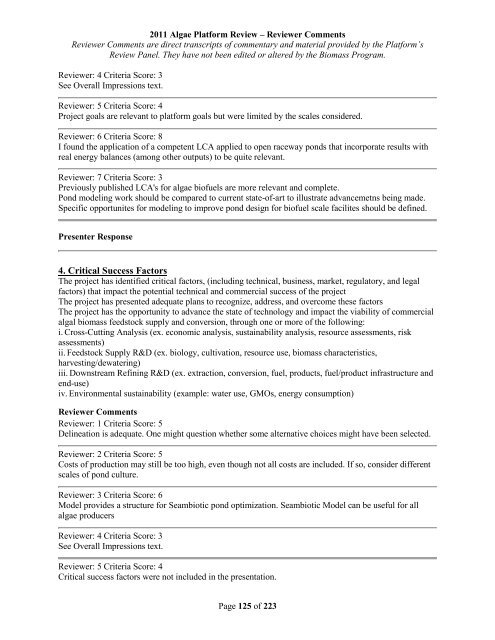Reviewer Comments - EERE
Reviewer Comments - EERE
Reviewer Comments - EERE
You also want an ePaper? Increase the reach of your titles
YUMPU automatically turns print PDFs into web optimized ePapers that Google loves.
2011 Algae Platform Review – <strong>Reviewer</strong> <strong>Comments</strong><br />
<strong>Reviewer</strong> <strong>Comments</strong> are direct transcripts of commentary and material provided by the Platform’s<br />
Review Panel. They have not been edited or altered by the Biomass Program.<br />
<strong>Reviewer</strong>: 4 Criteria Score: 3<br />
See Overall Impressions text.<br />
<strong>Reviewer</strong>: 5 Criteria Score: 4<br />
Project goals are relevant to platform goals but were limited by the scales considered.<br />
<strong>Reviewer</strong>: 6 Criteria Score: 8<br />
I found the application of a competent LCA applied to open raceway ponds that incorporate results with<br />
real energy balances (among other outputs) to be quite relevant.<br />
<strong>Reviewer</strong>: 7 Criteria Score: 3<br />
Previously published LCA's for algae biofuels are more relevant and complete.<br />
Pond modeling work should be compared to current state-of-art to illustrate advancemetns being made.<br />
Specific opportunites for modeling to improve pond design for biofuel scale facilites should be defined.<br />
Presenter Response<br />
4. Critical Success Factors<br />
The project has identified critical factors, (including technical, business, market, regulatory, and legal<br />
factors) that impact the potential technical and commercial success of the project<br />
The project has presented adequate plans to recognize, address, and overcome these factors<br />
The project has the opportunity to advance the state of technology and impact the viability of commercial<br />
algal biomass feedstock supply and conversion, through one or more of the following:<br />
i. Cross-Cutting Analysis (ex. economic analysis, sustainability analysis, resource assessments, risk<br />
assessments)<br />
ii. Feedstock Supply R&D (ex. biology, cultivation, resource use, biomass characteristics,<br />
harvesting/dewatering)<br />
iii. Downstream Refining R&D (ex. extraction, conversion, fuel, products, fuel/product infrastructure and<br />
end-use)<br />
iv. Environmental sustainability (example: water use, GMOs, energy consumption)<br />
<strong>Reviewer</strong> <strong>Comments</strong><br />
<strong>Reviewer</strong>: 1 Criteria Score: 5<br />
Delineation is adequate. One might question whether some alternative choices might have been selected.<br />
<strong>Reviewer</strong>: 2 Criteria Score: 5<br />
Costs of production may still be too high, even though not all costs are included. If so, consider different<br />
scales of pond culture.<br />
<strong>Reviewer</strong>: 3 Criteria Score: 6<br />
Model provides a structure for Seambiotic pond optimization. Seambiotic Model can be useful for all<br />
algae producers<br />
<strong>Reviewer</strong>: 4 Criteria Score: 3<br />
See Overall Impressions text.<br />
<strong>Reviewer</strong>: 5 Criteria Score: 4<br />
Critical success factors were not included in the presentation.<br />
Page 125 of 223




